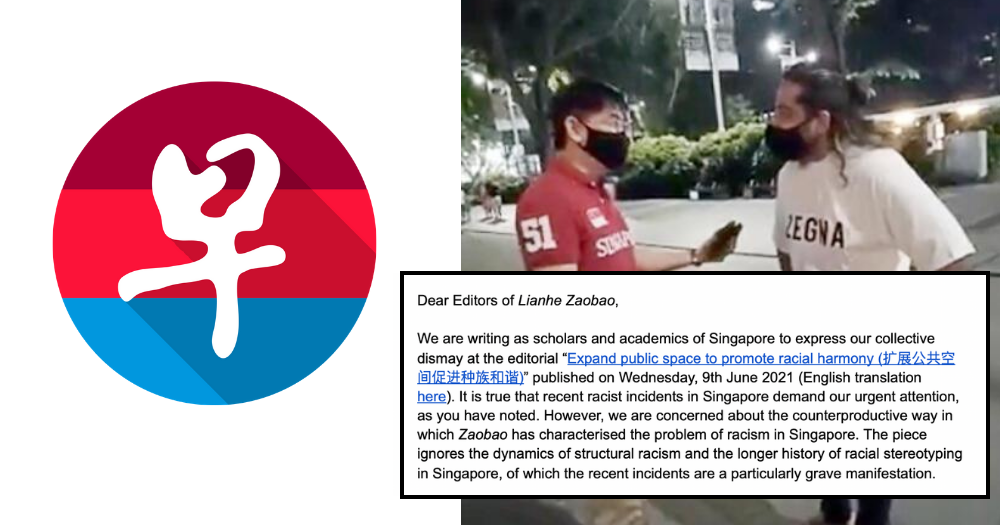Over the weekend, an open letter, written in response to Chinese daily Lianhe Zaobao (Zaobao) over its June 9 editorial, has since garnered over 200 signatories from local academics and scholars.
The open letter expressed "collective dismay" at the editorial ("Expand public space to promote racial harmony"), taking issue with how the editorial characterised the problem of racism in Singapore.
On June 15, Zaobao published a second editorial titled "Discussing sensitive racial issues rationally" to address the disappointment expressed and points made by the academics and scholars.
What are the academics and scholars unhappy about?
The open letter said that Zaobao's June 9 editorial "blames recent racist incidents on the uncertainty caused by the pandemic, the sensationalism of social media, and the import of 'foreign ideas' such as Critical Race Theory".
To these academics and scholars, this editorial therefore suggests the recent incidents are "an anomaly" and "ignores the dynamics of structural racism and the longer history of racial stereotyping in Singapore".
It also disagrees with the editorial's interpretation of CRT as "promoting hatred of white people" in the U.S., and by extension, of Chinese people in Singapore.
The letter took issue with the editorial's assumption that "Chinese privilege" in Singapore is "a direct importation of White privilege".
The letter argues that such interpretation of CRT is typically made by far-right commentators in the U.S. which do not engage in the actual writings and concepts of CRT and therefore it is "not befitting" for Zaobao to "parrot such claims".
The academics and scholars acknowledged that there is room for debate in how CRT may apply in the Singapore context but they find the framework is "useful for understanding racism in Singapore as structural and historical".
The assumption of "Chinese privilege" as a direct imported idea distracts Singaporeans from having meaningful and constructive conversations about racism, the open letter wrote.
Zaobao: See June 9 editorial in its entirety and part of ongoing discussion
In response to the letter, Zaobao said in its June 15 editorial, written in both Mandarin and English, that it has "publicly and unequivocally condemned" several recent local incidents of racial discrimination, and "jointly defended the hard-won racial harmony in public space" through its editorials as the anchor Chinese newspaper in Singapore.
Its stance on upholding equality among all races and advocating that there should be mutual understanding among ethnic groups has been consistent and evident in its editorials, news reports, and feature articles, it added.
Zaobao said that it has published seven editorials in the past year and a half in view of more racial tensions simmering in Singapore amid the pandemic.
It urged readers to see the June 9 editorial in its entirety as it analyses how the three factors contribute to recent racial tension, and CRT is an example of the influence of foreign ideas.
Zaobao noted on the academics' and scholars' views on CRT but disagrees that one should dismiss the critique of CRT by "serious scholars" as "far-right American perspective".
Zaobao also defended its analysis on the influence of foreign ideas, saying that theories and concepts stemmed from a foreign context may not always be applicable to Singapore.
"Sometimes, instead of deepening our understanding of the issue and promoting consensus, they may complicate it," it added.
That said, Zaobao acknowledges and accepts those who disagree with their views and positions in its editorial and welcomes rational and open discussion on the issue.
Summary of June 9 editorial
The June 9 editorial published by Zaobao was written after two high-profile racist incidents which elicited responses from politicians, including Minister of Home Affairs and Law K Shanmugam and Minister of Education Chan Chun Sing.
Zaobao said that Singaporeans generally are aware that racism is unacceptable and subscribe to the same philosophy of "regardless of race, language of religion" but the pandemic, the prevalence of social media and the influence of foreign ideas can exacerbate the tension between ethnic groups.
It will be challenging for a multi-racial society and/or a society that welcomes immigrants to maintain social harmony due to these three new conditions. It added that therefore Singapore cannot take racial harmony for granted and use archaic way of thinking and method to deal with racial issues.
Zaobao concluded that every individual has multiple identities and the key is that these identities are not mutually exclusive. It urged its readers to broaden their minds and expand their social circles to prevent further segregation of different ethnic groups through more interaction which can deepen mutual understanding.
It is indisputable that multiculturalism is Singapore's strength and it is important to acknowledge various cultural identities to develop our unique multicultural society, it adds.
Related stories
Top image via Zaobao, screenshot of open letter/Google Doc and Dave Parkash/video
If you like what you read, follow us on Facebook, Instagram, Twitter and Telegram to get the latest updates.
